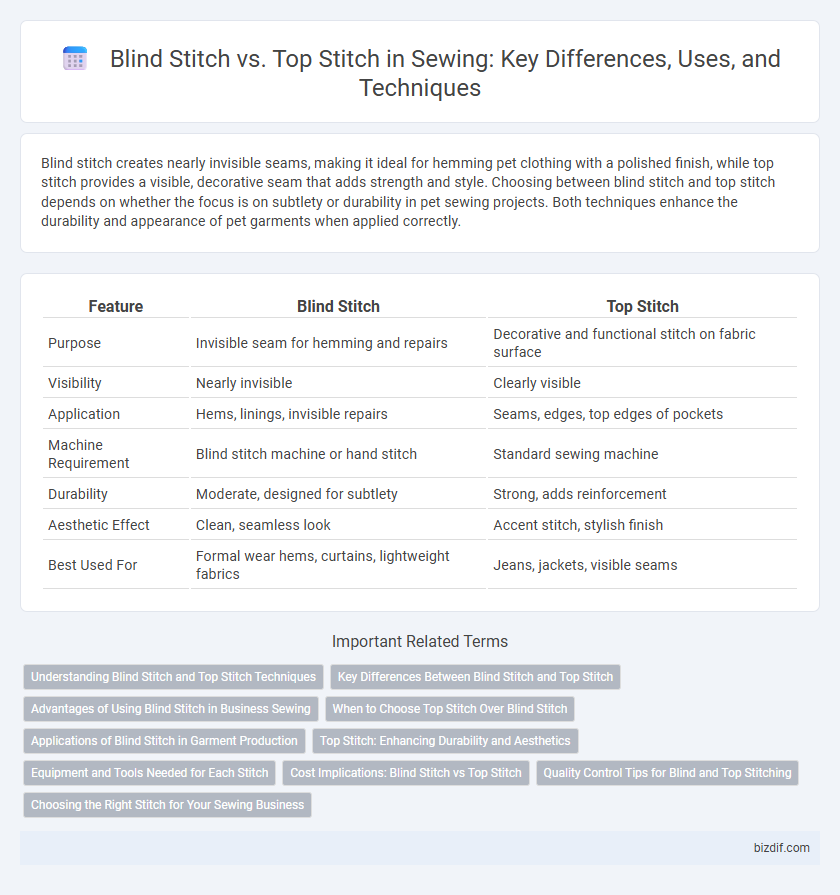Blind stitch creates nearly invisible seams, making it ideal for hemming pet clothing with a polished finish, while top stitch provides a visible, decorative seam that adds strength and style. Choosing between blind stitch and top stitch depends on whether the focus is on subtlety or durability in pet sewing projects. Both techniques enhance the durability and appearance of pet garments when applied correctly.
Table of Comparison
| Feature | Blind Stitch | Top Stitch |
|---|---|---|
| Purpose | Invisible seam for hemming and repairs | Decorative and functional stitch on fabric surface |
| Visibility | Nearly invisible | Clearly visible |
| Application | Hems, linings, invisible repairs | Seams, edges, top edges of pockets |
| Machine Requirement | Blind stitch machine or hand stitch | Standard sewing machine |
| Durability | Moderate, designed for subtlety | Strong, adds reinforcement |
| Aesthetic Effect | Clean, seamless look | Accent stitch, stylish finish |
| Best Used For | Formal wear hems, curtains, lightweight fabrics | Jeans, jackets, visible seams |
Understanding Blind Stitch and Top Stitch Techniques
Blind stitch creates nearly invisible seams by catching only a few threads of fabric, ideal for hems and delicate finishes. Top stitch, characterized by visible stitching on the fabric surface, enhances durability and adds decorative detail on collars and seams. Mastering both techniques enables precise garment construction and polished professional results.
Key Differences Between Blind Stitch and Top Stitch
Blind stitches are primarily used for invisible hems, where the thread is hidden to create a seamless finish, making them ideal for formal garments and delicate fabrics. Top stitches, on the other hand, involve visible stitching on the surface of the fabric, providing both decorative appeal and added durability, often seen on denim and outerwear. The key difference lies in visibility and function: blind stitches conceal seams, while top stitches emphasize and reinforce them.
Advantages of Using Blind Stitch in Business Sewing
Blind stitch offers a nearly invisible seam finish that enhances the professional appearance of garments, making it ideal for high-end fashion and custom tailoring businesses. This stitch reduces the risk of visible thread lines, which is crucial for maintaining the aesthetic quality of formalwear and delicate fabrics. Its subtlety also allows for seamless repairs and hemming without compromising the design, thereby increasing customer satisfaction and repeat business.
When to Choose Top Stitch Over Blind Stitch
Choose top stitch over blind stitch when durability and decorative visibility are key, especially in areas subject to frequent wear like collars, cuffs, and pockets. Top stitching reinforces seams and adds a polished finish that enhances garment structure, making it ideal for jeans, outerwear, and bags. Blind stitch suits hemming where a nearly invisible finish is preferred, but top stitch excels in creating bold, lasting seams that combine function with aesthetic appeal.
Applications of Blind Stitch in Garment Production
Blind stitch is primarily applied in garment production for hemming pants, skirts, and dresses to create an invisible finish that maintains the garment's aesthetic appeal. It is especially favored in formal wear and tailored clothing where a clean, seamless look is essential. This technique allows for secure hemming without visible top stitches, enhancing the garment's overall quality and craftsmanship.
Top Stitch: Enhancing Durability and Aesthetics
Top stitch sewing technique strengthens garment seams by adding visible, reinforced stitches along the fabric edges, improving both durability and design appeal. It is commonly used on jeans, jackets, and upholstery to provide a professional finish while securing layers firmly in place. Compared to blind stitch, which hides stitching for subtle closures, top stitch emphasizes decorative and functional seam strength, making it ideal for heavy-duty wear and stylish detailing.
Equipment and Tools Needed for Each Stitch
Blind stitch requires a specialized blind hem foot for sewing machines, along with matching thread and a sharp needle to create almost invisible hems. Top stitch demands a top stitch needle and often a top stitch foot to maintain even stitching, with heavier thread to enhance durability and visibility. Both stitches benefit from using fabric stabilizers and appropriate tension settings on the sewing machine to achieve professional results.
Cost Implications: Blind Stitch vs Top Stitch
Blind stitch sewing offers a cost-effective solution for invisible hems by reducing the need for hand-finishing and minimizing fabric damage, which lowers alteration expenses. Top stitch techniques, while more visible and potentially increasing thread costs, provide added durability and style that can enhance the garment's overall value and justify higher price points. Choosing between blind stitch and top stitch depends on balancing labor costs, material expenses, and the desired aesthetic impact on the finished product.
Quality Control Tips for Blind and Top Stitching
Blind stitch quality control requires ensuring precise fabric alignment and consistent stitch length to prevent visible holes and maintain a seamless finish, with regular tension checks to avoid puckering. Top stitching demands uniform thread tension and stitch spacing for aesthetic appeal and durability, alongside inspecting thread type compatibility with fabric to reduce wear and tear. Both techniques benefit from routine machine calibration and test stitching on scrap fabric to confirm optimal settings before production.
Choosing the Right Stitch for Your Sewing Business
Selecting the right stitch for your sewing business depends on the project's functional and aesthetic requirements. A blind stitch offers an invisible seam ideal for hemming garments where discreet finishing is essential, enhancing the garment's professional look without visible stitching lines. In contrast, a top stitch provides durability and decorative appeal on visible seams, reinforcing fabric edges while adding a stylish, polished detail that can elevate product design and consumer appeal.
Blind Stitch vs Top Stitch Infographic

 bizdif.com
bizdif.com